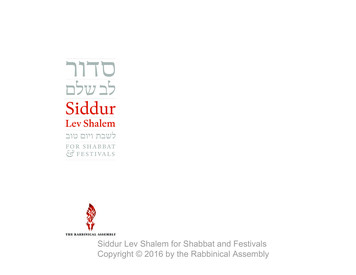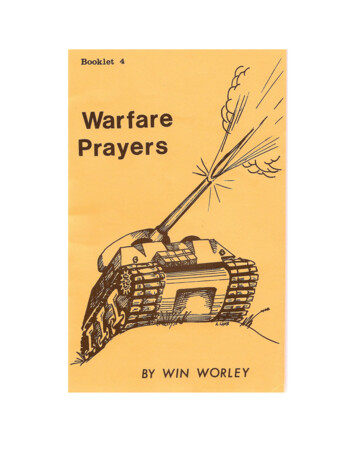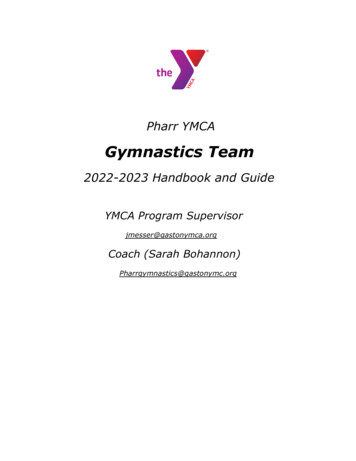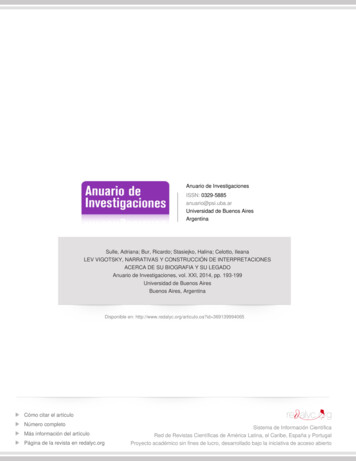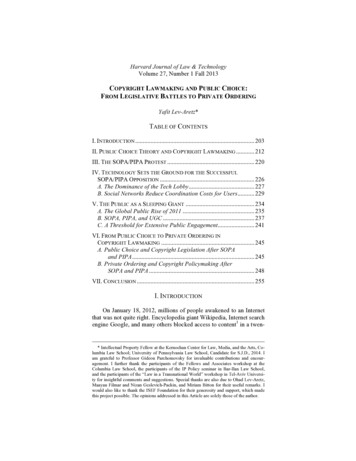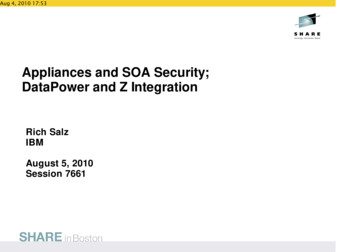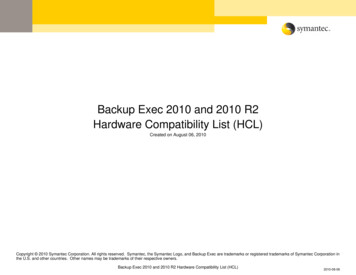
Transcription
Mahzor Lev Shalem. Copyright 2010 by the Rabbinical Assembly.This electronic version prepared for the sole use of Congregation Beth Shalom, Northbrook, Illinois.
מחזור לב שלם MAºZOR LEV SHALEM לימים הנוראים FOR ROSH HASHANAHAND YOM KIPPURT H E R A B B I N I C A L A S S E M B LYMahzor Lev Shalem. Copyright 2010 by the Rabbinical Assembly.This electronic version prepared for the sole use of Congregation Beth Shalom, Northbrook, Illinois.
Copyright 2010, 2011, 2012, 2014, 2016, 2019 by The Rabbinical Assembly, Inc.First edition, with corrections. All rights reserved.No part of this book may be reproduced or transmitted in any formor by any means, electronic or mechanical, including photocopy,recording or any information storage or retrieval system, exceptfor brief passages in connection with a critical review, withoutpermission in writing from:The Rabbinical Assembly3080 BroadwayNew York, NY 10027www.rabbinicalassembly.orgPermissions and copyrights for quoted materials may be found on page 467.Library of Congress Cataloging-in-Publication DataMahzor (Conservative, Rabbinical Assembly). High Holidays. English & Hebrew.880-01 [Mahzor Lev shalem la-Yamim ha-Nora’im] Mahzor Lev shalem forRosh Hashanah and Yom Kippur.p. cm.Text of mahzor in Hebrew with English translation; commentary in English.“Mahzor Lev shalem editorial committee, Rabbi Edward Feld, chair.”ISBN 978-0-916219-46-8 (alk. paper)1. High Holidays—Liturgy—Texts. 2. Mahzorim—Texts. 3. ConservativeJudaism—Liturgy—Texts. 4. Mahzor (Conservative, Rabbinical Assembly).High Holidays. I. Feld, Edward, 1943– II. Rabbinical Assembly of America.III. Title.BM675.H5Z647213 2010296.4'531047—dc222009075051Designed, composed, and produced byScott-Martin Kosofsky at The Philidor Company,Rhinebeck, New York. www.philidor.comThe principal Hebrew type, Milon, was designed and madeby Scott-Martin Kosofsky and Rabbi Scott Israel Seldowitz;it was inspired by the work of Henri Friedlaender. The othertypes are Arno and Cronos, by Robert Slimbach; Chapparal,by Carol Twombly; David, after Ismar David; Adobe Hebrew,by John Hudson; and Magma (titling), by Sumner Stone.Printed and bound in the United States of Americaby LSC Communications, Crawfordsville, Indiana.Eighth Printing18 17 16 15 14 13 12 11 10 9 8Mahzor Lev Shalem. Copyright 2010 by the Rabbinical Assembly.This electronic version prepared for the sole use of Congregation Beth Shalom, Northbrook, Illinois.
and generosity of לדור י ש ב through the devotion וגבורתי has been made possible ךי Mah.zor Lev Shaleml ידו ד ו ג ר ח מעשיך The publication ofI RMA AN D PAU L M I LSTE I Nin honor of their childrenROS LYN AN D J E ROM E M EYE RA B BY A N D HOWARD M I LSTE I NBAR BA RA AN D DAVI D ZALAZ N IC KROB I N AN D E DWARD M I LSTE I NMahzor Lev Shalem. Copyright 2010 by the Rabbinical Assembly.This electronic version prepared for the sole use of Congregation Beth Shalom, Northbrook, Illinois.
תוכן העניינים הקדמה TABLE OF CONTE NTSix ראש השנה introductionRosh Hashanah ערבית 1Evening Service ראש השנה בבית 29Rosh Hashanah at Home שחרית 33Morning Service סדר קריאת התורה ותקיעת שופר 95Torah Serviceand Shofar Blowing מוסף 124Musaf Service תשליך 176Tashlikh מנחה 178Afternoon ServiceA detailed list of subsectionsmay be found on the opening pagesof the major sections listed here. תוכן העניינים viMahzor Lev Shalem. Copyright 2010 by the Rabbinical Assembly.This electronic version prepared for the sole use of Congregation Beth Shalom, Northbrook, Illinois.
תוכן העניינים TABLE OF CONTE NTS יום כיפור yom kippur ערב יום כיפור בבית 198Erev Yom Kippur at Home כל־נדרי וערבית 201Kol Nidrei and Evening Service שחרית 33Morning Service שחרית – חזרת הש״ץ 251Repetition of the Morning Amidah סדר קריאת התורה 273Torah Service יזכור 290Yizkor מוסף 299Musaf Service מנחה 360Afternoon Service נעילה 391Concluding Service לימות חול weekday services מנחה לערב יום טוב 430Afternoon Service before the Holy Day ערבית למוצאי יום טוב 444Evening Service after the Holy Day אגרונים 460glossaries מקורות ורשויות 464sources and creditsviitable of contentsMahzor Lev Shalem. Copyright 2010 by the Rabbinical Assembly.This electronic version prepared for the sole use of Congregation Beth Shalom, Northbrook, Illinois.
MAH. ZOR LEV SHALEM EDITORIAL COMMITTEERabbi Edward Feld, Senior Editor and ChairRabbi Leonard GordonRabbi Stuart KelmanRabbi Alan LettofskyCantor Joseph LevineCantor Ken RichmondRabbi Robert ScheinbergRabbi Laurence SebertRabbi Jan Robyn UhrbachRabbi Jan Caryl Kaufman, ex-officioMahzor Lev Shalem. Copyright 2010 by the Rabbinical Assembly.This electronic version prepared for the sole use of Congregation Beth Shalom, Northbrook, Illinois.
I NTRODUCTIONTHE PRAYERBOOK represents the theology of the Jewish people throughout thegenerations. Not only is it an expression of popular religious feeling, but it is also atextbook of, and gateway into, the world of J ewish thought and imagination of thepast two thousand years.The prayerbook is a work of collective genius. On the one hand, learned and artful poets turned biblical verses and commentary into prayer; they even made legaltexts into liturgical poems. On the other hand, the basic liturgy is simple and direct,reflecting its origin in common communal experience. On several occasions, the willof the people overrode the decision of rabbis in determining the text and customarypractice of prayer.Our hope is that this High Holy Day mah.zor will allow each congregant to engagethe world of Jewish prayer in a vital way. In Jewish tradition, study and prayer havealways been intimately linked. With this in mind, this mah.zor consists of four mainelements linking study and prayer—the liturgical Hebrew text, translation, commentary, and meditational readings—each carefully prepared with attention to the contemporary worshipper.The Hebrew TextAll Jewish prayerbooks are anthologies of liturgical materials produced by generationsof Jews living in many lands. Traditional mah.zorim include biblical texts and prayers soold and so embedded in the liturgy that dating can only be approxi mated, sometimesonly within hundreds of years. Moreover, because Jews in every land have a daptedthe liturgy for their own use, a variety of liturgical strands have come down to us.The standard liturgy has come to include poems written throughout the Middle Agesenhancing earlier prayers and expressing the religious sensibilities of their times. Thismah.zor follows the form customarily used by Ashkenazic Jewry—the Jews descendedfrom Central and Eastern Europeans. Our manuscript sources show that while many piyyutim, liturgical poems, have been added or removed over time, the foundationaltexts have remained fairly consistent for the last several centuries, and we have triedto remain faithful to that longstanding tradition. To these b asic texts we have addedsome prayers used only by Sephardic Jewry—Jews descended from those living inthe Iberian peninsula and Arab lands—and by Italian Jewry. We have also addedixintroductionMahzor Lev Shalem. Copyright 2010 by the Rabbinical Assembly.This electronic version prepared for the sole use of Congregation Beth Shalom, Northbrook, Illinois.
con temporary prayers, since the prayerbook must give voice to the needs of our owngeneration, as it did for those in the past.The TranslationSeveral principles have guided this translation:1. We believe the translation ought to reflect the Hebrew original as closely as possible, allowing the English reader to experience the text without a filter, andallowing the congregant who has some basic familiarity with Hebrew to find familiar words. When the Hebrew text is jarring, which it sometimes is, the English translation ought not to smooth over the difficulty.2. The Hebrew prose frequently borders on the poetic, and the translation ought toconvey some sense of that in its cadence, in its form, and in its use of language.3. The translation ought to be prayerful; it ought to put the English reader in themood of prayer.4. Because each language has a distinct grammar, we have sometimes changedthe word order, syntax, and sentence structure to create an appropriate Englishtranslation.5. A contemporary American translation needs to be gender-neutral as far as possible, while conveying the intent and meaning of the original. Sometimes thishas necessitated changing the third person in the original to the second person,in this translation.6. We have consulted previous translations, especially the most recent version ofthe mah.zor for the Conservative movement (1972), which was edited and translated by R abbi Jules Harlow, as well as the re-edited Shabbat and Festival prayerbook, Siddur Sim Shalom (1998). We owe these sources a debt of gratitude—they were always our starting point, though the reader will readily recognize thisas a new and original translation. For the Morning Blessings and P’sukei D’zimra(Verses of Song), we have for the most part used the translations found in SiddurSim Shalom. And for the Torah and Haftarah readings, we have adapted DavidE. S. Stein’s The Contemporary Torah: A Gender-Sensitive Adaptation of the JPS ociety’s TaNaKh: The Holy Scriptures,Translation and the Jewish Publication Srespectively.7. The formula with which a b’rakhah begins, Barukh atah Adonai, is often translated as “blessed are You” or “praised are You.” We decided, however, not totranslate these standard opening words, for we felt that neither “blessed” nor“praised” is an adequate translation of barukh, and that it was important to convey that these words in Jewish liturgy function p rimarily as the formal introduction of a b’rakhah. A few other basic Jewish vocabulary words such as mitzvahlose all their deep overtones when translated, so most often they have simplybeen transliterated when they appear in English. הקדמה xMahzor Lev Shalem. Copyright 2010 by the Rabbinical Assembly.This electronic version prepared for the sole use of Congregation Beth Shalom, Northbrook, Illinois.
Running CommentaryWe believe that a modern commentary ought to accompany the ancient texts to inform the reader of their history, to explain unusual vocabulary, to comment on difficult ideas and key concepts, and to explain why a particular prayer appears in acertain context and is recited at a particular moment in the service. The commentarygenerally appears in the right margin. The commentary on Birkhot Ha-shah.ar andP’sukei D’zimra is adapted from Or Hadash, by Rabbi Reuven Hammer.Readings and MeditationsIn the left margin, we have included kavvanot, meditational readings to help congre gants focus at central moments, as well as readings that may be recited aloud. Wehave also provided some alternative renderings that offer a different approach to thetheological ideas raised by the text. Some of these kavvanot and readings are drawnfrom classical sources, while others are new prayers and meditations related to thetraditional context in which they are placed, that we hope will resonate with contemporary Jews. These readings do not represent a particular point of view or consistenttheological perspective. Rather, we have been conscious that a High Holy Day congregation is a diverse community and that what speaks to some will not resonate withothers. We hope that among the different voices you will find something that inspiresyour prayer.Special Vowels and SymbolsWe have noted where it is traditional for the congregation to bow with the signa. Readings are marked by roman type (prayer leader) alternating with italic(congregation). Readings that may be recited by the congregation as supplementsto the standard liturgy are marked with a ¶. The moment when the leader beginsreciting aloud is marked by an open triangle pointer .The Hebrew text font, made especially for this mah.zor by Scott-Martin Kosofsky, the book’s designer, includes the patah. g’nuvah, printed prior to a final guttural letter( –ע ַ –ח ַ –הּ ַ ), indicating that the vowel should be pronounced before the final consonant (for example, ֽר ַוּח as ru ah., not ruh.a). A special symbol is used for the kamatzkatan ( ) ׇא , the enlarged kamatz that denotes a vowel sound between ah and oh.The TransliterationWe have transliterated those parts of the service that are most often sung or chantedout loud, in order to encourage participation by all congregants. (These passages aregenerally indicated in the Hebrew by a bold typeface.) The following guidelines havebeen followed:Consonants: The transliteration distinguishes between gutturals ( ח h.) and ( כ kh). ה is always represented by h (even when silent).Neither א or ע is generally represented in the transliteration.xiintroductionMahzor Lev Shalem. Copyright 2010 by the Rabbinical Assembly.This electronic version prepared for the sole use of Congregation Beth Shalom, Northbrook, Illinois.
Vowels: a represents ַבּ ָבּ ֲבּ and is pronounced as in “father.”e represents ֶבּ ֱבּ and is pronounced as in “red.”ei represents ֵבּי ֵבּ and is pronounced as in “eight.”i represents ִבּי ִבּ and is pronounced as in “antique.”o represents בּוֹ בּ ֹ ׇבּ ֳבּ and is pronounced as in “crow.”u represents בּוּ ֻבּ and is pronounced as in “tuba.”ai represents ַבּי and is pronounced as in “aisle.”apostrophe: Vocal sh’va is represented by an apostrophe (e.g., b’rakhah, ) ְבּ ָרכָ ה .hyphen: Hyphens are used to indicate prefixes (e.g., ha-b’rakhah, ) ַה ְבּ ָרכָ ה .raised dot: Raised dots are used to indicate patah. g’nuvah (e.g., elo ah, ) ֱאלֽ ַוֹהּ ,as well as to break up a vowel cluster in the middle of a word(e.g., yisra el, )יִ ְשׂ ָר ֵאל .Our transliteration strives to facilitate accurate pronunciation of the Hebrewwords, and so exceptions to these guidelines have been made, from time to time, infavor of a more user-friendly rendering; note also that the names of the prayers andservices follow a more familiar transliteration style.AcknowledgmentsThroughout our work on Mah.zor Lev Shalem we realized that this mah.zor was notthe product of our committee’s work, but rather represents a window into the legacyof generations of Jews for whom the High Holy Day liturgy was a heightened experience. Our hope is that our efforts continue in this tradition and serve as inspiration for our own generation. Each meeting of the mah.zor committee began with theprayer recorded in the Mishnah that our work would not contain errors, mislead ourreaders, or be an impediment to true prayer. Now that we have completed our task,we hope that this mah.zor will be a source of inspiration to all who pray from it.Words cannot convey the gratitude we who served on the editorial committee feltas we met each month and grappled with this text. We learned much from our workand much more from each other. The fellowship that matured through these yearswill not be forgotten by us. Over the course of many years, members of the M ah.zorLev Shalem committee volunteered their time and energy for this new effort, andeach member of the committee had a significant role in the production of Mah.zorLev Shalem. Rabbi Stuart Kelman wrote the commentaries for the evening and morning Sh’ma and Its Blessings. He also contributed to the titling of all the sections of themah.zor and, along with Rabbi Leonard Gordon, wrote the commentary for the Torah and Haftarah readings. Rabbi Gordon wrote the commentary for Kol Nidrei,prepared the section of home rituals, worked with me in editing the Eilleh Ezk’rah forYom Kippur Musaf, and contributed creative material used throughout the mah.zor.Rabbi Alan Lettofsky worked on Rosh Hashanah Musaf as well as Ne ilah and devot הקדמה xiiMahzor Lev Shalem. Copyright 2010 by the Rabbinical Assembly.This electronic version prepared for the sole use of Congregation Beth Shalom, Northbrook, Illinois.
edly corrected each page of the entire manuscript. The committee utilized his linguistic skills throughout. Cantor Joseph Levine read the entire manuscript, with particular attention to the indications for congregational singing and leader’s chant, andhelped in our preparation of Ne ilah; he also wrote the chants for several of the newprayers included in the mah.zor. Cantor Kenneth Richmond also served as a consultant regarding the needs of musical leaders and he contributed several musical pieces.Rabbi Larry Sebert, along with Cantor Richmond, worked on the Torah service andYizkor and made many helpful suggestions incorporated throughout the mah.zor.Rabbi Jan Uhrbach was responsible for a major share of Rosh Hashanah Musaf andadded her literary sensibility to several other sections. Rabbi Robert Scheinberg was asource of expert advice on liturgical matters, as well as the author of the commentaryon the Shah.arit and Arvit Amidah for Rosh Hashanah and Yom Kippur. Rabbi JanKaufman served as the Rabbinical Assembly liaison for the committee. She coordinated our meetings, shared her insights and expertise, and reviewed and commentedon the entire manuscript at every stage of development.Several people served shorter terms on the committee: Francine Klagsbrun, whocontributed an important early editorial voice and served as a representative layperson; Rabbi Nina Beth Cardin, whose liturgical sensibility was helpful in the development of our thinking and who composed several new prayers for Kol Nidrei; RabbiAmy Eilberg, who developed the innovative Prayers of Brokenness and Wholeness;and Rabbi Lawrence Troster, who provided thoughtful insights.Mah.zor Lev Shalem owes a tremendous debt to the editors of other Rabbinical Assembly prayerbooks, most especially to Rabbi Jules Harlow, editor and translatorof the original Siddur Sim Shalom, published in 1985, and the Rabbinical AssemblyMah.zor, published in 1972. Many of the innovations that Rabbi Harlow pioneered inthe daily, Shabbat and Festival, and High Holy Day liturgy have been incorporated inthis mah.zor. One example is his addition—based on the 10th-century siddur of R.Saadia Gaon—of the word ba-olam to the final blessing of the Amidah, thus broadening the prayer for peace into a universal statement. We also used selections from thenew edition of Siddur Sim Shalom for Sabbath and Festivals (1998), edited by RabbiLeonard Cahan, and Siddur Sim Shalom for Weekdays (2002), edited by Rabbi AvramReisner, as well as the forthcoming volume of Siddur Sim Shalom—Home Rituals,also edited by R abbi Leonard Cahan.Members of the Committee on Jewish Law and Standards of the Rabbinical Assembly reviewed the manuscript and made some important suggestions. Specialthanks to its chair, Rabbi Elliot Dorff, and the chair of the Subcommittee on Liturgical Publications, Rabbi Robert Fine, for their cooperation and help.Many volunteer readers contributed valuable editorial suggestions at differentstages of development. Thanks are due to the many rabbis, cantors, scholars, and congregants who contributed feedback over the years. While it is not possible to namexiiiintroductionMahzor Lev Shalem. Copyright 2010 by the Rabbinical Assembly.This electronic version prepared for the sole use of Congregation Beth Shalom, Northbrook, Illinois.
everyone who commented, we appreciate the extensive suggestions we received. Special thanks to the following readers: Rabbis Martin Cohen, Michelle Fisher, DavidFreidenreich, Lilly Kaufman, Allan Kensky, Vernon Kurtz, Kenneth Leitner, ChaiLevy, David Lincoln, Daniel Nevins, Perry Rank, Joel Rembaum, Michelle Robinson,Peretz Rodman, Daniel Shevitz, Michael Singer, Robert Slosberg, Max Ticktin andJeffrey Wohlberg; as well as to Joy Ladin, Catherine Madsen, and Merle Feld. Specialthanks to Michael Bohnen who commented on almost every page, corrected bothHebrew and English grammar, cross-checked the translation, and suggested felicitousphrasing. He engaged in this labor of love in memory of his father, Rabbi Eli Bohnen,who had been a member of the editorial committee of the first and pioneering Rabbinical Assembly mah.zor. Professor Avraham Holtz was always at the ready to respond to our liturgical and grammatical questions. He reviewed the preliminary KolNidrei booklet and made extensive corrections. Professors Menahem Schmelzer andRaymond Scheindlin were consulted at various stages of our work.Sections of the mah.zor were piloted by six congregations and the participation ofthe rabbis, cantors, and members of the congregations in offering helpful feedbackwas greatly appreciated. Our thanks to Temple Israel Center (White Plains, NewYork); Har Zion Temple (Penn Valley, Pennsylvania); Congregation Beth Yeshurun(Houston, Texas); Beth Jacob Congregation (Mendota Heights, Minnesota); Congregation Netivot Shalom (Berkeley, California); and Congregation B’nai Israel(Northampton, Massachusetts).The secretaries to the mah.zor committee, Evan Schreiber and Jonah Rank, ensuredthat we had the necessary source material available to us. Jonah Rank also contributedhis knowledge of synagogue practice, compiled the glossaries that appear in this volume, and prepared the materials needed for permissions. Melissa Flamson handledthe permissions requests with care and professionalism.We owe a tremendous debt to the editorial and proofreading team, whose extensive knowledge, high standards, and painstaking devotion to detail is exemplary. Elisheva Urbas served as literary editor; her careful reading and extensive suggestionsclarified and improved the volume. Michelle Kwitkin-Close served as primary copyeditor at each stage of production; she lived with this book for many years and herthoughtful editing is reflected on every page. At the final stages, Rabbi David E. S.Stein, chief proofreader, provided oversight and coordination for an extensive andcomplex proofreading process and we are grateful for his diligence and care. Thanksalso to proofreaders Cynthia Goldstein, Emily Law, Eric Schramm, and Rabbi ReenaSpicehandler.Mah.zor Lev Shalem was expertly designed by Scott-Martin Kosofsky. His understanding and commitment to this project is apparent in the design, composition, andaesthetic of every page; it was a labor of love for him and he became a true partner inthe process of publishing this volume. Adrianne Onderdunk Dudden, the mah.zor’s הקדמה xivMahzor Lev Shalem. Copyright 2010 by the Rabbinical Assembly.This electronic version prepared for the sole use of Congregation Beth Shalom, Northbrook, Illinois.
earlier designer, set the stage for our first preliminary edition. Her death was mourned byall of us who worked with her.The staff of the Rabbinical Assembly helped at every stage of production. Rabbi JoelMeyers was the executive vice president of the Rabbinical Assembly during the years ofthis project’s development. He ensured that the resources were available to bring this project to fruition, and he was the one who suggested Lev Shalem as the title of the mah.zor.Rabbi Julie Schonfeld, the current executive vice president of the Rabbinical Assembly,brought this mah.zor to its completion. Amy Gottlieb, publications director of the Rabbinical Assembly, coordinated and supervised editing, proofreading, and production.Rabbi Wayne Franklin, chair of the publications committee, encouraged our work and abbis Irahelped smooth our way. Thank you to the former chairs of that committee, RStone, Ronald Isaacs, Martin Cohen, and especially Gordon Freeman, who originally invited me to take on this project. I would also like to acknowledge the current presidentof the Rab binical Assembly, Rabbi Jeffrey Wohlberg, as well as his predecessors, RabbisAlvin Berkun, Perry Rank, Reuven Hammer, Vernon Kurtz, and Seymour Essrog ז״ל .A special debt of gratitude is owed to Irma and Paul Milstein, whose generous gift hasenabled the publication of Mah.zor Lev Shalem. May they and their family be blessedthrough the prayers of the community of Israel.—Rabbi Edward FeldJanuary 2010 / Tevet 5770It has been a rare pleasure and privilege to work together u nder theexpert leadership of Rabbi Edward Feld, a creative and masterful editor, scholar, team-builder, and mensch. Over the years of this mah.zor’s development, Rabbi Feld delegated responsibilities, built consensus, nurtured ourrelationships, managed processes, and informed our decisions with his wideknowledge and fine sensibility. He focused our collective attention on the sacred work of producing a mah.zor that would best facilitate meaningfulprayer experiences in our diverse communities. The words in this mah.zorcome from a wide range of sources, but every page is imprinted by a singleand singular intellect and n’shamah. We are all very grateful.—Members of the Editorial CommitteexvintroductionMahzor Lev Shalem. Copyright 2010 by the Rabbinical Assembly.This electronic version prepared for the sole use of Congregation Beth Shalom, Northbrook, Illinois.
Mahzor Lev Shalem. Copyright 2010 by the Rabbinical Assembly.This electronic version prepared for the sole use of Congregation Beth Shalom, Northbrook, Illinois.
ערבית לראש השנה EVENINGSERVICE OFROSH HASHANAH הקדמה לתפילה 2 Preparatory Prayers שמע וברכותיה 5 The Sh’ma and Its Blessings תפילת העמידה בלחש 11 The Silent Amidah קידוש השנה 20 The Dedication of the New Year סיום התפילה 25 Concluding Prayers1rosh hashanah · evening serviceMahzor Lev Shalem. Copyright 2010 by the Rabbinical Assembly.This electronic version prepared for the sole use of Congregation Beth Shalom, Northbrook, Illinois.
הקדמה לתפילה Rosh Hashanah. Thecele bration of the NewYear involves a mixtureof emotions. On the onehand there is a sense ofgratitude at having livedto this time. Last year, wemay have prayed that webe given another year, andthankfully we are here tosee this day. Many of uscome to synagogue andjoyously greet old friendsand members of the community, both those weknow well and those wehave not seen for sometime. Some of us celebratethat we are once again with family. Traditionally, onewears new clothes on the holy day and we look forwardto a festive meal.On the other hand, the beginning of a new year raisesanxiety: What will my fate be this year? Will I live out theyear? Will I be healthy? Will I spend my time wisely, or willit be filled in a way that does not truly bring happiness?In turn these questions inspire even deeper self-reflection:What do I want out of life? What makes me proud? Whatmakes me ashamed? What are my most fundamentalcommitments? Rightfully, this day is called the “Day ofJudgment,” for in asking ourselves where we have beenand where we are going, what have we done, and in whatways we need to strike out on different and new paths,our lives this past year are judged and our future is determined. To stand before God means that we must faceultimate questions.The Rabbis formulated the variety of emotions of thisday by having God say to us, “Half this day is for you andhalf for Me” (Babylonian Talmud, Pesah.im 68b). It is a dayof extraordinary seriousness as we face our Creator andreveal our deepest selves. It is a day of joy as we revel inthe community surrounding us and celebrate the gift oflife with them. ָׁשלֹום ָׁשלֹום לָ ָרחֹוק וְ לַ ָּקרֹוב ָא ַמר יהוה , ֲא ֶׁשר יַ ְק ִׁשיב לַ ַּדל וְ יֵ ָע ֵתר , ַׁש ַּדי ַ? עד ָאן ְּת ֵהא ָרחֹוק ֶֽמנִּ י וְ ִת ָּס ֵתר , ֶא ְק ָרא ְבלֵ ב נָ כֹון , לַֽ יִ ל וָ יֹום ֶא ְעטֹוף ֶ. ּכִ י ַח ְס ְּדָך יֶֽ ֶתר , אֹודה לְ ָך ָת ִמיד , אֹוחיל לִ ִּבי ְבָך יִ ְב ַטח ִ לְ ָך , ַמלְ ּכִ י . פֹותר ֵ חֹולֵ ם ֲחלֹום ָסתּום יִ ְב ַטח ֲעלֵ י , לַ ְק ִׁשיב ְּת ִחּנָ ִתי : ִהּנֵ ה ְׁש ֵאלָ ִתי ֲ אֹות ָ. יֹותר ֵ לֹא ָפחֹות וְ לֹא , ּה א ַב ֵּקׁש Welcome ׁ ָשלוֹ ם . Isaiah 57:19.Mighty God ׁ ַשדַּ י . This poem by Solomon Ibn Gabirol(Spain, 11th century), written as a liturgical introduction(or r’shut), is recited in many different traditions, thoughat differing holy day times. ערבית לראש השנה · הקדמה לתפילה 2Mahzor Lev Shalem. Copyright 2010 by the Rabbinical Assembly.This electronic version prepared for the sole use of Congregation Beth Shalom, Northbrook, Illinois.
PRE PARATORY PRAYE RS¶ This Rosh Hashanah, eachof us enters this sanctuarywith a different need.Some hearts are full ofgratitude and joy:they are overflowing withthe happiness of love andthe joy of life;they are eager to confrontthe day, to make the worldmore fair;they have recovered fromillness or have escapedmisfortune.And we rejoice with them.Some hearts ache withsorrow:disappointments weighheavily upon them, andthey have tasted despair;families have been broken;loved ones lie in bed in pain;death has taken those whomthey cherished.May our presence andsympathy bring themcomfort.Some hearts are embittered:they have sought answersin vain;they have had their idealsmocked and betrayed;life has lost its meaning andvalue.May the knowledge that wetoo are searchingrestore their hope that thereis something to find.Words of WelcomeShalom: shalom to those who are far off, shalom to thosewho are near, says ADONAI.Mighty God who listens to the poor and hears their prayer:how long will You be distant and hidden from me?Night and day I turn, calling out with a true heart,always thanking You, for Your kindness, so great.My sovereign, my hope is in You; my heart trusts in You,as a dreamer of dreams depends on an interpreter.This I ask: hear my prayer.This I seek—not more, not less.—Solomon Ibn GabirolTo Seek RenewalOn this night, O God, we have come into Your houseto pray in Your sanctuary.But if the heavens are merely Your throne,if the earth is but Your footstool,If the heaven of heavens cannot contain You,how much less this house, built by mere human hands.Yet although Your dwelling place is every place,and although You can be sought and found in any place,It is to this place that we come most confidently—to seek renewal in Your purifying presence.—hershel J. mattSome spirits hunger:they long for friendship;they crave understanding;they yearn for warmth.May we in our commonneed gain strength fr
3. The translation ought to be prayerful; it ought to put the English reader in the mood of prayer. 4. Because each language has a distinct grammar, we have sometimes changed the word order, syntax, and sentence structure to create an appropriate English translation. 5. A contemporary American translation needs to be gender-neutral as far as pos-

